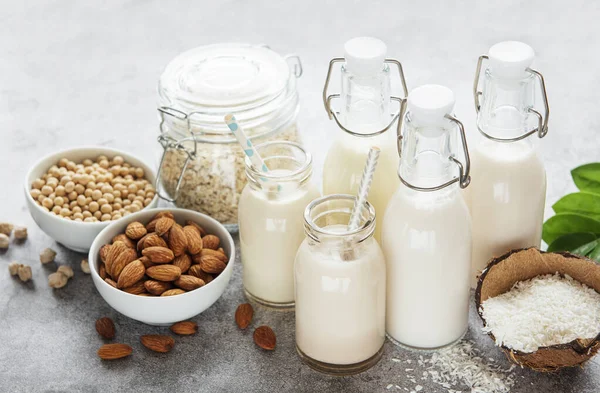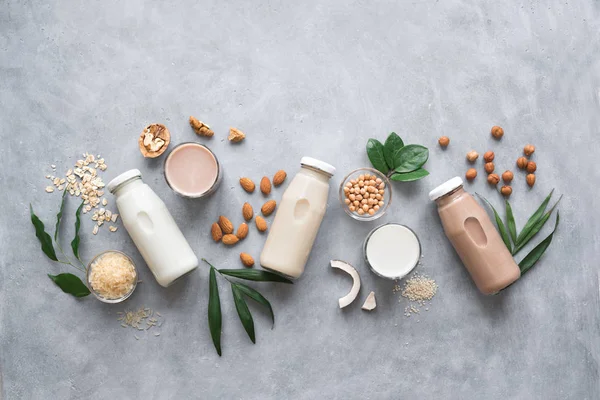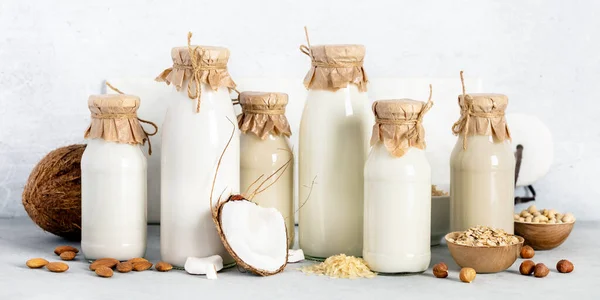
How to make your own plant-based milk at home
Are you tired of paying an arm and a leg for that fancy plant-based milk at the grocery store? Well, have no fear, because making your own plant-based milk at home is easier than you think! Not only is it cost-effective, but you also have complete control over the ingredients, meaning you can customize the flavor to your liking. Plus, you'll impress all your friends with your mad plant-based milk making skills.
Plant-based milk has become increasingly popular in recent years and for good reason, they are not only delicious but also offer a range of health benefits such as being low in calories, cholesterol and saturated fats, and rich in vitamins and minerals. Whether you're vegan, lactose intolerant, or just looking to switch things up, plant-based milk is a great alternative to traditional cow's milk. From almond milk to soy milk, oat milk, and more, there are plenty of options to choose from.
Making your own plant-based milk at home is not only easy but also fun and cost-effective, you can experiment with different ingredients, flavors and ratios to find your perfect homemade plant-based milk. In this article, we'll walk you through the process of making plant-based milk at home, from the equipment and ingredients you'll need to tips for straining and storing. So, grab your blender and let's get started on making your own delicious, homemade plant-based milk!
Types of plant-based milk

When it comes to plant-based milk, there are a plethora of options to choose from. Each type of plant-based milk has its own unique flavor, texture, and nutritional profile, making it easy to find one that suits your taste and dietary needs. Here are some of the most popular types of plant-based milk:
Almond milk: Made from ground almonds and water, almond milk is a great source of healthy fats and is low in calories. It has a nutty flavor and a creamy texture that makes it a popular choice for smoothies, coffee, and baking.
Soy milk: Made from whole soybeans or soy protein isolate, soy milk is a great source of protein and is often fortified with vitamins and minerals. It has a creamy texture and a slightly sweet taste that makes it a popular choice for coffee, cereal, and baking.
Oat milk: Made from rolled oats and water, oat milk is a great source of fiber and is often fortified with vitamins and minerals. It has a creamy texture and a slightly sweet taste that makes it a popular choice for coffee, cereal, and baking.
Rice milk: Made from ground rice and water, rice milk is a great source of carbohydrates and is often fortified with vitamins and minerals. It has a light texture and a slightly sweet taste that makes it a popular choice for cereal and baking.
Coconut milk: Made from coconut cream, coconut milk is a great source of healthy fats and is often used in curries, soups, and baking.
Cashew milk: Made from ground cashews and water, cashew milk has a creamy texture and a nutty flavor that makes it a popular choice for smoothies and baking.
Hemp milk: Made from ground hemp seeds and water, hemp milk is a great source of healthy fats and is often fortified with vitamins and minerals. It has a nutty flavor and a creamy texture that makes it a popular choice for smoothies and baking.
In summary, when it comes to plant-based milk, there are a plethora of options to choose from such as almond milk, soy milk, oat milk, rice milk, coconut milk, cashew milk, and hemp milk. Each type of plant-based milk has its own unique flavor, texture, and nutritional profile, making it easy to find one that suits your taste and dietary needs.
Benefits of making your own plant-based milk

Making your own plant-based milk at home has a plethora of benefits, not only it is cost-effective, but you also have complete control over the ingredients, meaning you can customize the flavor to your liking. Here are some of the benefits of making your own plant-based milk:
Cost-effective: Store-bought plant-based milk can be quite expensive, especially if you're a regular consumer. Making your own plant-based milk at home can save you a significant amount of money in the long run.
Control over ingredients: When you make your own plant-based milk, you have complete control over the ingredients, which means you can avoid unwanted additives and preservatives that are often found in store-bought versions.
Customizable flavor: When you make your own plant-based milk, you can experiment with different ingredients, flavors, and ratios to find your perfect homemade plant-based milk.
Reduce waste: store-bought plant-based milk often comes in non-recyclable cartons, by making your own plant-based milk you can reduce the amount of waste
Freshness: Plant-based milk bought from stores can often sit on shelves for long periods of time before it reaches your home, making your own plant-based milk ensures that you are consuming a fresh product.
Variety: You can make different types of plant-based milk from different nuts and seeds, giving you a variety to choose from, unlike store-bought options that might be limited.
Nutritional value: Store-bought plant-based milk often contain added sugars and other ingredients that may not be beneficial for your health. When you make your own plant-based milk, you can control the nutritional value of the milk and make sure that you're consuming a healthy product.
In summary, making your own plant-based milk at home has many benefits, it is cost-effective, you have complete control over the ingredients, you can customize the flavor, reduce waste, ensure freshness
Equipment and ingredients

Making your own plant-based milk at home doesn't require any fancy equipment, just a few basic kitchen tools that you probably already have. Here's a list of equipment and ingredients you'll need to make plant-based milk at home:
Equipment:
Blender: A high-speed blender is ideal for making plant-based milk, but a regular blender will also work.
Cheesecloth or nut milk bag: This is used to strain the milk and remove any bits of pulp.
Measuring cups and spoons
Jars or bottles for storing the milk
A pot for heating up the milk (if desired)
Ingredients:
Nuts or seeds of your choice (almonds, cashews, soybeans, hemp seeds, etc.)
Water
Sweetener (optional) such as honey, maple syrup or agave
Vanilla extract or any other flavorings (optional)
It's worth noting that the ratio of nuts to water depends on the type of nut or seed you use, and the consistency you prefer. A general ratio is 1 cup of nuts to 4 cups of water, but you can adjust this to suit your taste.
In summary, making your own plant-based milk at home doesn't require any fancy equipment, just a few basic kitchen tools such as a blender, cheesecloth or nut milk bag, measuring cups and spoons, jars or bottles for storing the milk and a pot for heating up the milk (if desired). In terms of ingredients, you will need nuts or seeds of your choice, water, sweetener and vanilla extract or any other flavorings (optional). The ratio of nuts to water depends on the type of nut or seed you use, and the consistency you prefer, A general ratio is 1 cup of nuts to 4 cups of water, but you can adjust this to suit your taste.
Basic recipe for making plant-based milk

Making your own plant-based milk is easy and only requires a few simple steps. Here's a basic recipe for making plant-based milk:
Soak the nuts or seeds: Soak the nuts or seeds of your choice overnight in water. This helps to soften them and makes them easier to blend.
Drain and rinse the nuts or seeds: Drain the water and rinse the nuts or seeds.
Blend: Add the nuts or seeds and 4 cups of fresh water to a blender. Blend on high speed for 2-3 minutes or until the mixture is smooth and creamy.
Strain: Pour the mixture through a cheesecloth or nut milk bag to strain out any bits of pulp.
Sweeten and flavor (optional): If desired, add sweetener and flavorings such as vanilla extract to the milk.
Chill: Transfer the milk to a jar or bottle and chill in the refrigerator for at least 1 hour before using. The milk will last for up to 5 days in the refrigerator.
In summary, making your own plant-based milk is easy and only requires a few simple steps such as soak the nuts or seeds overnight, drain and rinse them, blend them with water, strain the mixture through a cheesecloth or nut milk bag, sweeten and flavor if desired, chill the milk in the refrigerator for at least 1 hour before using, and it will last for up to 5 days in the refrigerator.
Variations on the basic recipe

Once you have mastered the basic recipe for making plant-based milk, you can start experimenting with different ingredients, flavors, and ratios to create your own unique variations. Here are some ideas for variations on the basic recipe:
Chocolate milk: Add cocoa powder or chocolate chips to the basic recipe for a chocolatey twist.
Spiced milk: Add cinnamon, nutmeg, or pumpkin spice to the basic recipe for a warm and cozy twist.
Creamy milk: Add some coconut cream or avocado to the basic recipe for an extra creamy texture.
Sweetened milk: Add a touch of honey, maple syrup, or agave nectar to the basic recipe for a sweeter taste.
Vanilla milk: Add vanilla extract or vanilla bean to the basic recipe for a vanilla-flavored twist.
Nut-free milk: Experiment with seeds such as sunflower, pumpkin or sesame instead of nuts.
Herbed milk: Add fresh herbs such as mint or basil to the basic recipe for a refreshing twist.
Frozen milk: Freeze the milk in an ice cube tray and use them in smoothies for a creamy texture.
In summary, once you have mastered the basic recipe for making plant-based milk, you can start experimenting with different ingredients, flavors, and ratios to create your own unique variations such as chocolate milk, spiced milk, creamy milk, sweetened milk, vanilla milk, nut-free milk, Herbed milk or even frozen milk. The possibilities are endless, have fun experimenting and enjoy your homemade plant-based milk!
Tips for straining and storing

Straining and storing your homemade plant-based milk properly can ensure that it stays fresh and has the best texture and flavor. Here are some tips for straining and storing plant-based milk:
Straining: Straining the milk through a cheesecloth or nut milk bag is essential to remove any bits of pulp and ensure a smooth texture. Make sure to wring out the cheesecloth or nut milk bag to remove as much liquid as possible.
Storing: Transfer the milk to a clean, airtight jar or bottle and store it in the refrigerator. Make sure to use a clean spoon or pour spout to avoid contamination.
Shelf life: Homemade plant-based milk will last for up to 5 days in the refrigerator. Be sure to check the expiration date, if you find any mold or strange smell it's best to discard it.
Freezing: Plant-based milk can also be frozen, pour it in ice cube trays or airtight containers and it will last for up to 3 months in the freezer. Thawing frozen milk before using it is recommended as it tends to separate when frozen.
Label and date: Make sure to label and date your homemade plant-based milk, so you know when it was made and when it should be consumed.
In summary, Straining and storing your homemade plant-based milk properly can ensure that it stays fresh and has the best texture and flavor. Straining the milk through a cheesecloth or nut milk bag, transfer it to a clean, airtight jar or bottle and store it in the refrigerator. Homemade plant-based milk will last for up to 5 days in the refrigerator, you can also freeze it for up to 3 months. Be sure to label and date your homemade plant-based milk, so you know when it was made and when it should be consumed.
Uses for leftover pulp 

When making your own plant-based milk, you may be left with a good amount of pulp. But don't throw it away just yet! There are many ways to use the leftover pulp that can save you money, reduce food waste and even add some extra nutrients to your meals.
Baking: The leftover pulp can be used in baking recipes such as bread, muffins, cookies, and cakes.
Smoothies: Add the leftover pulp to your smoothies for an extra boost of fiber and nutrients.
Crackers: Mix the leftover pulp with spices and seasonings, roll it out and dehydrate or bake it to make your own crackers.
Soups and sauces: Add the leftover pulp to soups, stews, and sauces to thicken and add flavor.
Compost: If you don't want to use the pulp in your cooking or baking, you can always add it to your compost bin, the pulp will decompose and enrich the soil with essential nutrients.
Animal feed: If you have chickens or other backyard animals, the pulp can be used as animal feed.
In summary, the leftover pulp from making plant-based milk can be used in various ways such as baking, smoothies, crackers, soups, sauces, compost, or even as animal feed. These are some ways to make use of the leftover pulp and reduce food waste. Be creative and have fun experimenting with new ways to use the pulp.
The environmental impact of plant-based milk production

As the demand for plant-based milk increases, it's important to consider the environmental impact of its production. While plant-based milk is often seen as a more sustainable alternative to traditional cow's milk, the production of some types of plant-based milk can have a negative impact on the environment. Here are a few things to consider:
Water usage: Some types of plant-based milk, such as almond milk, require a large amount of water to produce. This can lead to water scarcity in regions where almonds are grown.
Deforestation: The cultivation of soybeans, a common ingredient in plant-based milk, can lead to deforestation, particularly in South America.
Transportation: Plant-based milk is often transported long distances, leading to a larger carbon footprint.
Packaging: Many plant-based milk cartons are not recyclable, leading to a greater amount of waste.
Monoculture: Many plant-based milk producers rely on monoculture farming, which can lead to soil degradation and loss of biodiversity.
However, it's also worth noting that many companies are taking steps to reduce their environmental impact by using sustainable practices, such as using renewable energy, reducing water usage, and using recyclable packaging. Additionally, some plant-based milk alternatives, such as oat milk, have a lower environmental impact compared to others.
In summary, while plant-based milk is often seen as a more sustainable alternative to traditional cow's milk, the production of some types of plant-based milk can have a negative impact on the environment such as water usage, deforestation, transportation, packaging and monoculture. However, many companies are taking steps to reduce their environmental impact by using sustainable practices, such as using renewable energy, reducing water usage, and using recyclable packaging. Additionally, some plant-based milk alternatives, such as oat milk, have a lower environmental impact compared to
Conclusion
In conclusion, making your own plant-based milk at home is a cost-effective and delicious way to have control over the ingredients and ensure the freshness of your milk. It can also be a fun and creative experience, with endless possibilities for flavor variations. Additionally, by making your own plant-based milk, you reduce the waste of packaging, and you can make use of the pulp by using it in cooking and baking.
However, it's also important to consider the environmental impact of plant-based milk production, and to make informed choices about the types of plant-based milk we consume.
In summary, making your own plant-based milk is a cost-effective and delicious way to have control over the ingredients and ensure the freshness of your milk, it also can be a fun and creative experience with endless possibilities for flavor variations. Additionally, by making your own plant-based milk, you reduce the waste of packaging, and you can make use of the pulp by using it in cooking and baking. However, it's also important to consider the environmental impact of plant-based milk production, and to make informed choices about the types of plant-based milk we consume.
How to make your own plant-based milk at home
 Reviewed by jadan
on
January 21, 2023
Rating:
Reviewed by jadan
on
January 21, 2023
Rating:
 Reviewed by jadan
on
January 21, 2023
Rating:
Reviewed by jadan
on
January 21, 2023
Rating:




No comments: